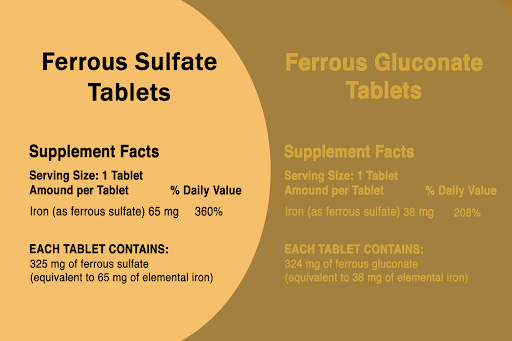Your iron supplement dose depends on how much iron you need and how well you tolerate iron. Taking your iron pill every other day and combining it with vitamin C may help you get the most benefit from your supplement.
About 2 in 3 people worldwide don’t get enough iron, including roughly 1 in 7 American adults. People who menstruate are far more likely to need more iron. Low iron can cause fatigue and weakness and make it harder to function through your day. Additionally, low iron can lead to iron deficiency anemia (low red blood cell counts). Either way, supplementing with oral iron can help.
Just remember, not everyone with an iron deficiency has noticeable symptoms. And not everyone with anemia symptoms has low iron. The best way to assess your iron needs is by having your clinician order blood tests that check your iron levels and blood counts. If you have low iron, they can help you figure out why, so those causes can be addressed, too.
✅ Check out this previous TNG post, “Should I take an iron supplement?”
Below, we share information on how to take an iron pill to get the most benefit.
➡️ The iron content in your supplement
The elemental iron is your iron dose. The amount of “elemental iron” in a supplement can be found in the “Supplement Facts” section on the label. You can compare iron supplements by looking at how much elemental iron each dose contains.

Note on the above comparison between ferrous sulfate and ferrous gluconate how supplements can have about the same iron salt weight while containing very different amounts of elemental iron.
✅ Ferrous iron salts are widely used and inexpensive iron supplement options. For more info, check out this previous TNG post, “Which iron supplement is best?”
➡️ How much iron to take
Just like there’s no best supplement type, there isn’t a standard iron supplement dose. Here are some general guidelines:
✅ A general dosing range is 20 to 100 mg of elemental iron once daily.
✅ Doses above 45 mg are more likely to cause side effects, such as constipation and other gastrointestinal discomfort.
✅ Taking doses larger than 65 mg may not provide additional benefit since the extra iron is unlikely to get absorbed.
Your clinician will recommend an iron dose for you based on how much iron you need and how likely you are to tolerate oral iron. Elemental iron doses up to 200 mg per day are sometimes prescribed. However, newer research suggests these larger doses mostly cause more side effects without extra iron getting absorbed.
Keep in mind, these iron doses are for people who have low iron. Taking extra iron when you don’t need it isn’t a good idea. The amount of iron in a multivitamin is unlikely to cause a problem. Still, it’s best to talk with your clinician before taking iron.
➡️ Best way to take oral iron
No matter the source, only a small percent of iron is absorbed from the gut. Normally, this protects our bodies from too much iron getting absorbed, leading to iron overload. But lower absorption means it takes longer for oral iron supplements to correct a deficiency.
There are some things you can do to improve iron absorption (the amount of iron that moves from your gut into your body).
✅ Take iron on an empty stomach.
✅ Take iron with vitamin C, either in the form of a supplement or with vitamin C-rich foods like orange juice.
✅ Take iron every other day (or Mon-Wed-Fri).
Iron is absorbed best when your stomach is empty. Many foods bind to iron and prevent it from being absorbed. Common culprits include calcium- or fiber-rich foods, coffee, or tea. Conversely, vitamin C may enhance iron absorption. Some iron supplements are paired with vitamin C for this effect.
Alternate-day dosing is becoming a more popular way of taking oral iron — and this tip is backed by some research. A 2019 meta-analysis (study of 25 studies) found that taking iron on non-consecutive days worked about the same as taking it every day. It turns out, spacing your iron pills further apart may help them be better absorbed and cause fewer side effects.
Iron pills can cause nausea, heartburn, and constipation. It’s okay to take your iron with a small amount of food if it helps you avoid stomach upset.
💡 Before starting an iron supplement, share your list of medications or supplements with your clinician. You may need to carefully space your doses apart to avoid unwanted interactions. For example, taking iron with supplements containing calcium, magnesium, or zinc may interfere with iron’s absorption.
➡️ How to tell if an iron supplement is working
Iron supplements usually start working within the first month. If your low iron was making you feel crummy, you might start feeling better during these first few weeks.
However, the only way to know for sure that your iron pills are working is to have your iron levels rechecked. Typically, labs are rechecked about 3 months after starting an iron supplement (or sooner if anemia is severe).
Your clinician may recommend IV iron if your iron levels haven’t improved much. But even if your supplements are working, it’s common to need to continue taking them.
🗓️ It may take up to 6 months of regularly taking oral iron to replenish iron stores.
If you menstruate, your clinician may recommend continuing to supplement while you’re having periods. Either way, ask your clinician what you can do to help ensure your iron levels stay in a healthy range going forward.
Stay nourished. Stay informed. And stay supplement-safe.
Further reading:
About 1 in 4 Americans may have inadequate iron intake or absorption


